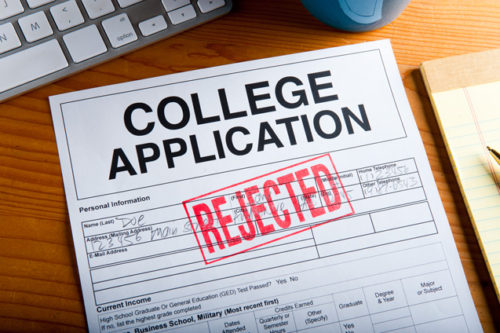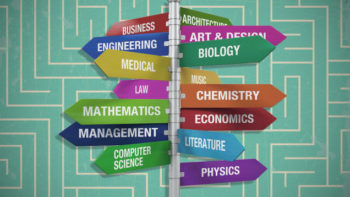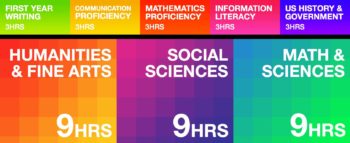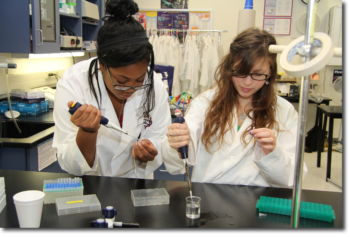
When talking with families in our community and reading what is written and said on the Internet and in forums like college confidential, we see that much of the conventional wisdom about college admissions is misguided. In our community, parents and students often wonder why they don’t gain acceptance to the colleges that they are most attracted to. Much of the college admissions process seems unclear and overwhelming. College admissions mistakes occur because families, and many high schools and counselors, lack a full understanding of how the process works and which factors are crucial.
Additionally, the colleges themselves have a way of dancing around the important information as they market and sell their offerings. We must acknowledge that college admissions is a subjective process where success is not entirely related to academic achievement, grades, and test scores, nor the size of one’s resume. This acknowledgment is difficult because it is a challenge to our basic ideas about how the world works.
As the important elements in college admissions are changing all of the time, we must pay very close attention to the reality of what is happening now and not rely on outdated ideas. We have ongoing relationships with college admissions staffs and professors, hiring managers and graduate school admissions staffs, and research curricula, employment patterns, and student outcomes 365 days per year. This information helps us to give your family the best advice possible. More information about the major factors in college admissions and how your child’s application will be evaluated can be found in this post.
To help your family avoid disappointment at college acceptance time, we offer you the top 10 college admissions mistakes.
1. Sending in Poor Quality Essays and Applications
My father and partner, Dr. Shumsky, was an admission committee member at Northwestern University and the University of Virginia, elite universities where nearly every applicant is in the top 10% of their high school class. One would expect such universities to receive top-notch essays, resumes, and applications from their applicants. Yet, each year, the in-boxes were filled with low quality essays, resumes, and recommendations.
Our colleagues in admissions departments at competitive colleges like Emory University, Vanderbilt, Macalester, Bowdoin, The University of California system, and The University of Texas At Austin report the same problem. One colleague at UT-Austin commented thus about the quality of applications and essays, “nearly 90% are terrible, with another 5% in the poor range.” Yes, admissions rates are plunging because of increased competition, but good applications still stand out like diamonds.
The primary reason students in our community do not achieve the results at acceptance time that are equal to their strong high school achievements is that the quality of their essays is below par. Most students and families mistakenly believe the college essay must sell the school on the student by pointing out the student’s good traits.
Admissions staff read tens of thousands of essays and nearly all are the same. Student faced minor challenge and overcame challenge by strength of character. Student won contest and felt proud or student lost contest and found merit and value in the process. These kinds of essays bore readers and fail to give a taste of the student’s real voice, experience, and identity.
High quality essays are authentic, personal, detailed, and interesting to admissions readers. If you don’t have good essays, your prospects are vastly reduced.
2. Not Understanding Different Types of Colleges and the Traits That Distinguish Them
College education is not a widget that is exactly the same at every college or university, even when comparing the same major at two or more schools. Different schools have different missions, different size/scale, varying availability of professor interaction, and varied pedagogical methods.
 Public research universities with 25,000-65,000 undergraduate students (UT-Austin, A&M, UCLA, U of Alabama, etc.) offer large (200 or more students), mostly lecture oriented classes, with discussion-based courses available only to upper division students, if at all.
Public research universities with 25,000-65,000 undergraduate students (UT-Austin, A&M, UCLA, U of Alabama, etc.) offer large (200 or more students), mostly lecture oriented classes, with discussion-based courses available only to upper division students, if at all.
Smaller private colleges with approximately 2,000 students, sometimes called liberal arts colleges or teaching universities (Trinity TX, Amherst, Williams, Pomona), typically offer nearly all courses in discussion-based settings, with a small number of lecture courses. Nearly all classes are 25 or less, with many classes of 10-15 students.
Medium sized universities, typically private with 5-10,000 undergrads (Ivies, Stanford, SMU, TCU, Tulane, Vanderbilt), with some larger 10-20k undergraduates (USC, NYU, BU, Baylor), vary in the kinds of teaching styles and settings on offer. Some do a great job in limiting large lecture classes and mandating professor support for undergrads, many do not.
We have had dozens students come to us in the last decade after a semester or two of personal and academic struggle at UCLA, UT-Austin, Texas A&M, LSU, and many other flagship public universities. In nearly every case, the students remarked that the biggest obstacle to their success was the overwhelming size and scale of the university.
These students were surprised that all of their classes were large lectures of 300-plus students with professors who  were not helpful. Their families, high school staff, and teachers had not advised them (obviously they had not worked with us on college admission) that these universities were massive in scale and could prove difficult to navigate.
were not helpful. Their families, high school staff, and teachers had not advised them (obviously they had not worked with us on college admission) that these universities were massive in scale and could prove difficult to navigate.
Many other uninformed students and families are surprised that Penn and other Ivies have lots of lecture classes that have 100 or more students and professors who are not so available as hoped for. BU, USC, and NYU and many other medium-sized private universities are notorious for offering 1st and 2nd year classes that have several hundred or more students like those found at public research universities.
3. Assuming private universities are too expensive or not worth the price.
The average discount at private universities was 48.6% in 2015. With an average yearly total cost sticker price of just less than $35,000, an education at the 725 private colleges ranked by US News frequently ends up as less expensive than public universities, especially when compared to out of state public universities.
Here’s the math: $35,000 minus 48.6% discount ($16,800) equals $18,200 in total cost on average for private universities. UT-Austin estimates their yearly total cost for Texas residents at $23-25,000, as does Texas A&M.  Neither of these schools will give middle class students a dime of aid, unless the student is an elite academic scholar. Many private universities will cost your family less than the flagship public universities in Texas, or your home state, and will provide many more valuable services.
Neither of these schools will give middle class students a dime of aid, unless the student is an elite academic scholar. Many private universities will cost your family less than the flagship public universities in Texas, or your home state, and will provide many more valuable services.
Further, we must raise the question of value. If most of the classes your child attends have 150 or more students and most tests are multiple choice, then what is the real quality of his or her coursework? If a college costs less money, but does much less to help your son or daughter grow and build skills and experiences that will positively impact their career prospects, then is that college providing a worthwhile return on your investment?
4. Failing to Visit Prospective Colleges
In today’s hyper-competitive admissions landscape, colleges pay close attention to student visits. For admission staff, visits are an indication of the student’s interest and seriousness about the school and the admission process. Even public universities are now taking inventory of sign-ins at the admissions office. A visit, tour, and over night campus stay could be the difference between acceptance and denial.
night campus stay could be the difference between acceptance and denial.
Further, campus visits during in-session periods of class are the best way to get a thorough understanding of the campus culture, academic climate, and campus social life. Visit classes and departments, the school bookstore, and try to connect with faculty and staff. Arrange for an overnight stay in the dorms, meet and interview current students. That’s how you find out what is really going on at the college, beyond the marketing materials, fancy websites, and shiny fitness centers.
5. Starting too late
To kill the most deadly myth of college admission, let me make it very clear to you: 9th grade performance counts! There are too many students and families running around with the idea that my 9th grade, and even 10th grade academics are not critical in college admission decision making. WRONG!!!
9th grade is not as important as 10th or 11th grade, which are the most important years in the minds of admissions officers, but no one is given a free pass on 9th grade performance, in or out of class. Furthermore, it is important to  start working on your extra-curricular activities from your first day of high school.
start working on your extra-curricular activities from your first day of high school.
If you have consistent work, with increasing depth, on an interest, activity, or academic subject over the course of 4 years of high school, you are well on your way to standing out from the crowd of nearly identical applications. If you can do so with 2 activities, interests, or subjects, then you are likely going to be a strong applicant at most colleges and universities.
College admission staff, like Harvard Dean of Admission William Fitzsimmons, have long advised that the college admission process takes several years to work through if one is to make informed choices. At a minimum, one should start planning course work and extra-curriculars before starting high school. College research and investigation of majors and career paths should ideally start no later than 10th grade. Campus visits should also begin in 9th and 10th grade and interviews, if applicable, in 11th grade.
Standardized testing such as the ACT and SAT should be completed by June of 11th grade. Very few students hit their target score the first time through, so take your first test in the winter of 11th grade and give yourself at least an additional 2 chances to reach your top score. SAT Subject Tests should be taken in June of the year that the course was given. For example, if you take chemistry in 10th grade, then you are best served by taking the SAT Subject Test in June of that year. The material will never be more fresh in your mind.
All of these steps, and many more, take careful thought and deliberation that cannot be side-stepped. If you, like most American families, wait until spring of 11th grade to get serious about college admission, then you will have much more stress and uncertainty than is necessary. Make it easy for yourself and start early!
6. Not Understanding Majors and College Curricula
Just as said above, college education is not a widget that is the same at every university, even in the same department. Said simply, economics may be a completely different program at Penn than it is at University of Texas at Austin. The history department at SMU may focus on contemporary issues in American history since 1900, while the history department at Wheaton may focus on the history of the enlightenment and the origins of Western civilization.
Further, the teaching style, kinds of texts used and the methods of examination could be vastly different from one  university to the next. Even within a university, there is great variation from department to department. STEM education (Science, Technology, Engineering, Mathematics) is often quite different from programs in the social sciences, arts and humanities, and pre-professional areas of the curriculum. STEM majors typically have a heavier workload (20-30 or more hours per week outside of class) than their peers in other majors (12-15 hours per week outside of class).
university to the next. Even within a university, there is great variation from department to department. STEM education (Science, Technology, Engineering, Mathematics) is often quite different from programs in the social sciences, arts and humanities, and pre-professional areas of the curriculum. STEM majors typically have a heavier workload (20-30 or more hours per week outside of class) than their peers in other majors (12-15 hours per week outside of class).
For example, The engineering program at USC may offer lots of hands-on guidance from professors, but in business, USC may have large classes and professors who have little interest in supporting undergraduates. Some universities and majors allow students to begin taking focused coursework in their major from day one. Others require a specific order of coursework or do not allow students to take focused courses until taking the “pre-major” requirements.
Additionally, there is the issue of general education requirements or core curricula. Nearly every university in America requires some minimum of classwork across the major areas of the curriculum as a general requirement for  graduation. Some, like Texas A&M, UCLA, and UT-Austin demand lots of specific coursework and a minimum of courses in science, mathematics, social science, arts and humanities, and foreign culture. At those universities, undergraduates spend nearly 50% of their time in required core or general education classes.
graduation. Some, like Texas A&M, UCLA, and UT-Austin demand lots of specific coursework and a minimum of courses in science, mathematics, social science, arts and humanities, and foreign culture. At those universities, undergraduates spend nearly 50% of their time in required core or general education classes.
At other colleges and universities, a much smaller set of requirements is demanded of each student. The number of general education requirements is critical information because general education courses are often boring and students tend to acquire lower grades in them because of lack of interest. If you are the type of student that does not do well in courses that do not engage you, then you should look for colleges that have smaller general education or core curricula. You will not want enroll in a college that forces you to spend half of your time in classes that are not related to your area of study or interests.
7. Focusing on the Wrong Variables
What matters most in your college experience is the quality of the education you receive and how it lays the foundation for the first stages of your career. You must find schools that will challenge you and engage your curiosities and that have a strong program in your area of interest. However, attaining solid grades is imperative if you are to get into graduate school or acquire a good job upon graduation. You must then attend a school where you will be able to succeed academically.
The following factors do not matter or matter very little: the prestige of the college, the student-faculty ratio, the average starting pay of recent graduates, the luxury of the dorms, the record of the football team, the famous alumni and superstar faculty.
The following factors are crucial: percentage of first and second year classes that use multiple choice tests  (aim for less than 30%), percentage of students graduating in 4 years (minimum 60%), percentage graduating in 6 years (minimum 70%, with at least 80% preferred), percentage of first and second year classes that you are likely to take that have 30 students or less (minimum 50%), quality and availability of career services, quality and availability of learning support services (especially if you have a learning or attention problem), availability of professors for one-to-one guidance and mentoring, availability and ease of study abroad programming, placement rate in graduate school and percentage of recent grads in full-time jobs in student’s field of study within 6 months of graduation.
(aim for less than 30%), percentage of students graduating in 4 years (minimum 60%), percentage graduating in 6 years (minimum 70%, with at least 80% preferred), percentage of first and second year classes that you are likely to take that have 30 students or less (minimum 50%), quality and availability of career services, quality and availability of learning support services (especially if you have a learning or attention problem), availability of professors for one-to-one guidance and mentoring, availability and ease of study abroad programming, placement rate in graduate school and percentage of recent grads in full-time jobs in student’s field of study within 6 months of graduation.
8. Putting Too Much Emphasis on High Prestige “Dream Schools”
Nearly every child in America would love to attend Harvard, Stanford, Rice, or Vanderbilt. They are highly prestigious institutions filled with some of the strongest and most successful students and faculty in the world. Of course, they are attractive to you and your teenaged child! Yet, these are not by any means the only best fit schools for your son or daughter.
 Finding schools that your child dreams about attending is the easy part of the college admissions process. What about the schools they are very likely to be admitted to? That’s always a more difficult component of the college research effort. Success in college admissions requires that you recognize that some schools are so highly competitive that you may not be admitted, even with a great portfolio of grades, scores, and activities.
Finding schools that your child dreams about attending is the easy part of the college admissions process. What about the schools they are very likely to be admitted to? That’s always a more difficult component of the college research effort. Success in college admissions requires that you recognize that some schools are so highly competitive that you may not be admitted, even with a great portfolio of grades, scores, and activities.
Do not put all of your hopes and energy into applications to dream colleges and universities. This is a strategy that will surely lead to disappointment. You must recognize that while it is nice to be accepted to dream schools, your first job as an applicant is to find schools where you can be happy, get a great education, and are very likely to be accepted or are solidly in the median range of middle class applicants.
You must find safe choices where you can be happy! There is no point in applying to a college just because you will be admitted. If you are not going to be happy there, or are not confident in the quality of education, then you should not apply. Every student in America needs 2 safe choices where he or she can get a great education and be happy.
If you want to apply to 5 dream schools in addition to 2 safe choices and 2 target/median range choices, then go ahead. But do not let denial from dream schools sink your ship. Success while you are enrolled in college is much more valuable to your career prospects then admission to a dream school. In the end, what matters is getting a great education, building skills and career training, and having an engaging and fun college experience. There are hundreds of great colleges and universities that will deliver all of the above.
9. Spending Too Much Time and Effort on The Wrong Activities
College admissions staffs think about applicants much differently than you or your high school staff might imagine. Today’s admissions staffs do not put as much emphasis on athletics, performing arts, and school clubs as in years past, unless the student will pursue the activity as an extra-curricular or major while in college. For most applicants, these activities will not add much value to their portfolio.
Admissions staffs are very concerned about the current generation of applicants having inflated resumes and simply following what Mom, Dad, or the school pushed them to do. If you want to catch the eye of admissions, then you need to pursue activities and experiences that are going to stretch your life experiences and push you out of the bubble of your school and neighborhood. Your portfolio should contain depth of commitment over several (preferably 3 or more) years of high school across two or three major areas.
Mature students are expected to go after the interests that they are passionate or curious about. Diving deep into prospective academic or career paths is especially valuable, both for the student’s development and in terms of giving weight to the portfolio. Independent research papers and projects, intern or work roles, challenging yourself to face issues and communities far out of your comfort zone; these are the prized elements of a strong application portfolio.
10. Rushing to Apply Early
Early admission plans may not make much impact on your chance of admission at most colleges. Nearly all middle class high school parents and school staff members are pressuring students to apply early as if it were a magic formula for assured acceptance. They quote endless statistics about the percentage of acceptance being much higher for early applications.
College personnel further push the agenda of early applications when they speak at high schools and in informational meetings.  Let us spill a couple of raindrops on that fire. Could it be that early application is more of a tool in the college’s interest than it is for students? Colleges are businesses and want to lock down those who will be attending, gauge the strength of their current applicant pool, and determine the efforts they need to spend in further recruiting and budgeting as soon as possible. Might that may be the reason they push early applications?
Let us spill a couple of raindrops on that fire. Could it be that early application is more of a tool in the college’s interest than it is for students? Colleges are businesses and want to lock down those who will be attending, gauge the strength of their current applicant pool, and determine the efforts they need to spend in further recruiting and budgeting as soon as possible. Might that may be the reason they push early applications?
Here’s why early application may not do much to increase your odds of acceptance. First, the very best applicants apply early and at most schools, the early applicant pool is far stronger than the regular decision pool. Early action (non-binding early application) does very little to help your chance of acceptance at most competitive colleges. Yet, every year, families are in a hasty rush to get all applications in by early action deadlines. This frequently leads to lower quality essays and applications.
Early decision (binding early application) does give a more significant boost to your chances of admission, but usually not as much as it did in the decades gone by. At the most competitive schools, it may even harm your chances of admission because the early decision pool is much stronger than regular decision.
Some schools and families use early decision as a strategic card to be played for raising a student’s odds at the most competitive college on their list. This is a mistake. One should only apply early decision if a college is head and shoulders above the other schools on their list.
Teenagers are evolving organisms and very few are clear about the school that is their top choice. Often students feel that one school is by far their top choice in September, but by February have an entirely different perspective. Don’t get stuck with a binding offer of admission at a college that isn’t your top choice.
Frequently ignored in the rush to apply early is that some students would be much more likely to be accepted in the regular pool. Early applications require admissions to make a decision by Christmas time, before the 12th grade first semester grades are received. If a student has had a mixed record, but will produce their strongest academic performance to date in the fall of 12th grade, then that student should not apply early.
Don’t rush, take your time and create the best application possible. Do not use early application as a strategic card that you must play. If you can complete a great application in time for early deadlines, then go ahead and do so. If not, regular deadlines are just fine.
